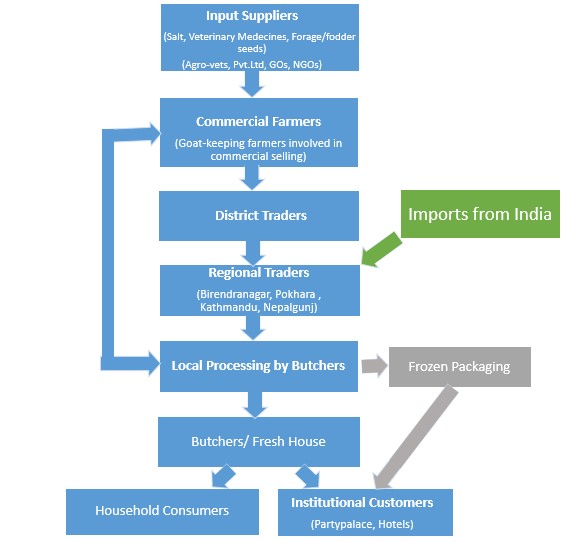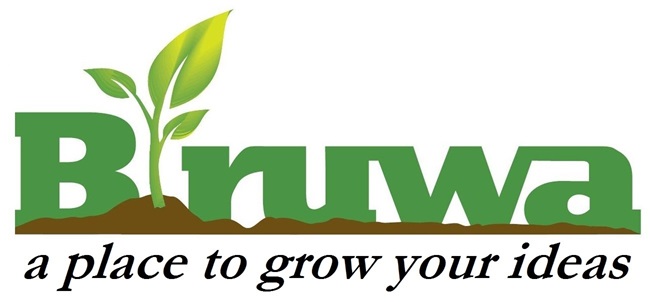
Tax Registration System in Nepal: Questions regarding PAN and VAT
February 23, 2018
Government Funds: Loan Support for Entrepreneurs in Nepal (FY 2074-75)
April 16, 2018Goat Meat Industry in Nepal: Opportunities and Challenges
With the consumption all over the country among all the cultural, social and ethnic groups, goat meat is the second most consumed meat in Nepal after buffalo meat, and constitutes for a quarter of all meat consumed despite the highest cost per unit weight. Goat meat industry has a good market potential for the budding entrepreneurs and investors if they could capitalize on the growing market demand.
Value Chain of Goat meat Industry
Generally, Nepali farmers rear goats through traditional model of stall-feeding or grazing in near-by forests. Most of the farmers, especially in the rural areas, are involved in goat farming due to low investment requirements. While private organizations like Agro-vets supply inputs like salt, veterinary medicines and forage/fodder seeds to the farmers, whereas government agencies like DLSO (District livestock services office) and Local NGOs provide technical knowledge and necessary inputs.
Farmers usually sell live goats either to the traders or directly to the local butchers. Retailers like butchers and fresh houses then buy live goats from traders, process them and sell it to the customers, hotels, restaurants and party venues. Traders usually handle the selling process by using trucks/bus.
Similarly, meat processing involve cleaning, removing inedible parts and wrapping it in plastic for storage. After storing the processed meat in deep freeze for the long period of time, they are delivered to household and institutional customers in main markets like Pokhara and Kathmandu through insulated van.
Figure 1: Value chain of Goat meat Industry

Table 1: Major End markets for Goat meat in Nepal
| Major End Markets for Goat Meat | |
| Local Market | Surkhet, Jumla, Jajarkot, Kalikot, Dailekh |
| Sub-national Market | Nepalgunj, Birendranagar |
| National Market | Pokhara, Kathmandu |
Table 2: Popular Goat breeds in Nepal
|
Popular Goat Breeds in Nepal |
|
| Khari | Dominant breed of nepal
Reared in the Terai to the mid-hills Capacity to resist common diseases and withstand climate variation. |
| Jamunapari | Indian origin breed
Common in the hilly region of Nepal Larger growth potential and relatively larger body size |
| Sirohi | Indian origin breed
Found in mid-hills and western valleys of Nepal Certain levels of Sirohi blood has been found mixed with khari goat |
| Sinhal and Chyangra | Mountain goats
Reared in mountain districts of Nepal Places like Jumla and Kalikot |
| Boer goat | Popular breed of meat
Boer goat farming is slowly gaining popularity in Nepal Mostly imported from Australia |
Demand and supply gap
Being a major delicacy, the demand for goat meat/meat products are high in Nepal, especially during festive season like Dashain where thousands of goats are sacrificed every year and also during election campaigns where the candidates lure voters through incentive of providing free meat. Besides, Nepalese people are fond of many varieties of goat meat dishes like sekuwa (meat roasted in natural wood/log fire), sukuti (dry meat dish), taas (fried goat meat dish), bhutan (dish made from goat’s gut) and many more.However, Nepal hasn’t yet been self-sufficient in the production of Goat meat to support the demand. On the hand, Nepal seriously lacks proper technology in rearing, housing and processing. Whereas, on the other hand, there is not enough storage facilities, clean slaughterhouses, and proper distribution systems. Adding to that, there is inadequate scientific research on breeding, feeding, management, and disease control. And, all these scenarios are hindering large scale commercial production in Nepal.To meet the demand, there is high imports of live goats from India. According to NLTA (Nepal Livestock Traders Association), two-lakhs live goats enter Nepal every year through checkpoint at Nepalgunj, Krishnanagar and Bhairahawa. So, looking at the present context, there is a serious urgency of upgrade in technology to gear up the commercial production process.
Challenges to growth:
The goat meat industry in Nepal is surrounded with several constraints and challenges that needs to be addressed for the growth of this industry, which are discussed below:
- Lack of proper technology in rearing, breeding and housing management (space, air flow and slot management).
- No easy access to market information on price, volume traded, market context of live goat/meat to farmers and traders.
- There is a limited number of goat collection centers in Nepal, and the existing collection centers are of poor quality lacking reconditioning facility which results weight-loss up to 20% while handling or transporting them to the distant market.
- Lack of elite flock based goat resource centers that promotes high-quality cross breeding facilities.
- Lack of expertise and efforts in processing activities. For instance, there are very limited slaughterhouses, meat processing factories and deep fridge/cool centers. Also, the conditions of most of the available slaughterhouses’ do not meet the standards set by the government under ‘Animal Slaughterhouse and Meat Inspection Act’.
- Poor effort of loan disbursement by the government and high interest rate in the banking sector are limiting the farmers from scaling up their production activity.
Opportunities and way forward:
Also, as mentioned below, there exist several opportunities in this industry.
- Private sector led support services such as agro-vets, and related shops have the scope of rendering health service in the remote parts of the districts.
- Community forestry and public land (leasing for agro forestry) could serve as large resource for feeding management for a larger scale of goat rearing.
- Road corridors are developing in the remote areas which is supporting easy transportation of live goat/meat to the distant market.
- For the flow of capital investment to the goat production and trading business, many local co-operatives are being established in the remote areas with the support from development banks.
To sum up, the demand for goat meat/meat products in Nepal is constantly high and are accepted and consumed by all communities in Nepal. If the producers and concerned stakeholders adopt better technology and skilled manpower in production and distribution systems, Nepal could scale up its production in goat meat to meet the market demand. (This article was prepared with the help of report published by HVAP (High Value Agricultural Project in Hill and Mountain Areas http://www.hvap.gov.np/notice.php)
Biruwa Advisors provides support in Private Sector Development and preparing business plans. For more information, click the link to our service pages.

